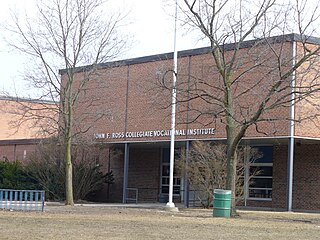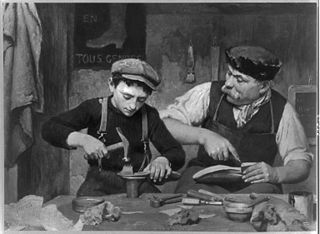
Vocational education is education that prepares people to a skilled craft as an artisan, trade as a tradesperson, or work as a technician. Vocational Education can also be seen as that type of education given to an individual to prepare that individual to be gainfully employed or self employed with requisite skill. Vocational education is known by a variety of names, depending on the country concerned, including career and technical education, or acronyms such as TVET and TAFE.

Apprenticeship is a system for training a new generation of practitioners of a trade or profession with on-the-job training and often some accompanying study. Apprenticeships can also enable practitioners to gain a license to practice in a regulated occupation. Most of their training is done while working for an employer who helps the apprentices learn their trade or profession, in exchange for their continued labor for an agreed period after they have achieved measurable competencies.

Carpentry is a skilled trade and a craft in which the primary work performed is the cutting, shaping and installation of building materials during the construction of buildings, ships, timber bridges, concrete formwork, etc. Carpenters traditionally worked with natural wood and did rougher work such as framing, but today many other materials are also used and sometimes the finer trades of cabinetmaking and furniture building are considered carpentry. In the United States, 98.5% of carpenters are male, and it was the fourth most male-dominated occupation in the country in 1999. In 2006 in the United States, there were about 1.5 million carpentry positions. Carpenters are usually the first tradesmen on a job and the last to leave. Carpenters normally framed post-and-beam buildings until the end of the 19th century; now this old-fashioned carpentry is called timber framing. Carpenters learn this trade by being employed through an apprenticeship training—normally four years—and qualify by successfully completing that country's competence test in places such as the United Kingdom, the United States, Canada, Switzerland, Australia and South Africa. It is also common that the skill can be learned by gaining work experience other than a formal training program, which may be the case in many places.
A journeyman is a worker, skilled in a given building trade or craft, who has successfully completed an official apprenticeship qualification. Journeymen are considered competent and authorized to work in that field as a fully qualified employee. They earn their license by education, supervised experience and examination. Although journeymen have completed a trade certificate and are allowed to work as employees, they may not yet work as self-employed master craftsmen.

A tradesperson is a skilled worker that specializes in a particular trade. Tradespeople usually gain their skills through work experience, on-the-job training, an apprenticeship program or formal education.

A plumber is a tradesperson who specializes in installing and maintaining systems used for potable (drinking) water, and for sewage and drainage in plumbing systems.
Education in the United Kingdom is a devolved matter with each of the countries of the United Kingdom having separate systems under separate governments. The UK Government is responsible for England, whilst the Scottish Government, the Welsh Government and the Northern Ireland Executive are responsible for Scotland, Wales and Northern Ireland, respectively.

Education in Greece is centralized and governed by the Ministry of Education and Religious Affairs at all grade levels in elementary and middle school. The Ministry exercises control over public schools, formulates and implements legislation, administers the budget, coordinates national level university entrance examinations, sets up the national curriculum, appoints public school teaching staff, and coordinates other services.

A vocational school, trade school, or technical school is a type of educational institution, which, depending on the country, may refer to either secondary or post-secondary education designed to provide vocational education or technical skills required to complete the tasks of a particular and specific job. In the case of secondary education, these schools differ from academic high schools which usually prepare students who aim to pursue tertiary education, rather than enter directly into the workforce. With regard to post-secondary education, vocational schools are traditionally distinguished from four-year colleges by their focus on job-specific training to students who are typically bound for one of the skilled trades, rather than providing academic training for students pursuing careers in a professional discipline. While many schools have largely adhered to this convention, the purely vocational focus of other trade schools began to shift in the 1990s "toward a broader preparation that develops the academic" as well as technical skills of their students.

Durham College is a public university in Ontario, Canada, with two main campuses in Oshawa and Whitby. Durham College offers over 145 academic programs, including five honours bachelor degrees and nine apprenticeship programs, to around 13,600 full-time students.

A glazier is a tradesperson responsible for cutting, installing, and removing glass. They also refer to blueprints to figure out the size, shape, and location of the glass in the building. They may have to consider the type and size of scaffolding they need to stand on to fit and install the glass. Glaziers may work with glass in various surfaces and settings, such as cutting and installing windows, doors, shower doors, skylights, storefronts, display cases, mirrors, facades, interior walls, ceilings, and tabletops.
A dual education system combines apprenticeships in a company and vocational education at a vocational school in one course. This system is practiced in several countries, notably Germany, Austria, Switzerland and in the German-speaking Community of Belgium, but also for some years now in South Korea.

Delta Secondary School was a Canadian high school in Hamilton, Ontario. Built in 1925, it was one of the oldest high schools in the city. It was located on 1284 Main Street East, and is connected to the Delta Honeybears Daycare. The school had an estimated enrollment of 841 students and is part of the Hamilton-Wentworth District School Board. The school was permanently closed in 2019.
SkilledTradesBC is a provincial government agency in the province of British Columbia, Canada.
West Credit Secondary School is a high school in Mississauga, Ontario, Canada. It is a workplace or college destination for the Peel District School Board. Its cousin school, Judith Nyman Secondary School is a high school in Brampton, Ontario, Canada that offers similar trades courses. West Credit and Judith Nyman are currently the only two vocational schools in the Peel District School Board and offer students more choices in trades courses than most other Peel high schools. West Credit S.S. is aimed at students who want to pursue a career in the trades, or sometimes it is recommended for those with an Individual Education Plan (IEP) at the vocational 1 and 2 level. Both high schools offer vocational and applied level courses. Students can participate in programs leading to apprenticeship and can work towards their required apprenticeship courses and training upon completing their Ontario Secondary School Diplomas.
Instrument mechanics in engineering are tradesmen who specialize in installing, troubleshooting, and repairing instrumentation, automation and control systems. The term "Instrument Mechanic" came about because it was a combination of light mechanical and specialised instrumentation skills. The term is still is used in certain industries; predominantly in industrial process control.
Unlicensed assistive personnel (UAP) are paraprofessionals who assist individuals with physical disabilities, mental impairments, and other health care needs with their activities of daily living (ADLs). UAPs also provide bedside care—including basic nursing procedures—all under the supervision of a registered nurse, licensed practical nurse or other health care professional. UAPs must demonstrate their ability and competence before gaining any expanded responsibilities in a clinical setting. While providing this care, UAPs offer compassion and patience and are part of the patient's healthcare support system. Communication between UAPs and registered nurses (RNs) is key as they are working together in their patients' best interests. The scope of care UAPs are responsible for is delegated by RNs or other clinical licensed professionals.
The Ontario College of Trades was the regulatory body that governs skilled trades in Ontario. The College officially opened on April 8, 2013 and its activities are mandated by the Ontario College of Trades and Apprenticeship Act, 2009 (OCTAA).

Red Seal Program, specifically known as The Interprovincial Standards Red Seal Program is a program that sets common standards for tradespeople in Canada. It is a partnership between the Canadian federal government, the provinces and the territories.











